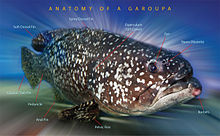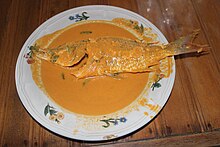| Grouper | |
|---|---|

| |
| Gag grouper, Mycteroperca microlepis | |
| Scientific classification | |
| Domain: | Eukaryota |
| Kingdom: | Animalia |
| Phylum: | Chordata |
| Class: | Actinopterygii |
| Order: | Perciformes |
| Family: | Serranidae |
| Subfamily: | Epinephelinae Bleeker, 1874 |
| Tribes and genera | |
|
See text | |
Groupers are fish of any of a number of genera in the subfamily Epinephelinae of the family Serranidae, in the order Perciformes.
Not all serranids are called "groupers"; the family also includes the sea basses. The common name "grouper" is usually given to fish in one of two large genera: Epinephelus and Mycteroperca. In addition, the species classified in the small genera Anyperidon, Cromileptes, Dermatolepis, Graciela, Saloptia, and Triso are also called "groupers". Fish in the genus Plectropomus are referred to as "coral groupers". These genera are all classified in the subfamily Epiphelinae. However, some of the hamlets (genus Alphestes), the hinds (genus Cephalopholis), the lyretails (genus Variola), and some other small genera (Gonioplectrus, Niphon, Paranthias) are also in this subfamily, and occasional species in other serranid genera have common names involving the word "grouper". Nonetheless, the word "grouper" on its own is usually taken as meaning the subfamily Epinephelinae.
Description

Groupers are teleosts, typically having a stout body and a large mouth. They are not built for long-distance, fast swimming. They can be quite large: in length, over a meter. The largest is the Atlantic goliath grouper (Epinephelus itajara) which has been weighed at 399 kilograms (880 pounds) and a length of 2.43 m (7 ft 11+1⁄2 in), though in such a large group, species vary considerably. They swallow prey rather than biting pieces off of them. They do not have many teeth on the edges of their jaws, but they have heavy crushing tooth plates inside the pharynx. They habitually eat fish, octopuses, and crustaceans. Some species prefer to ambush their prey, while others are active predators. Reports of fatal attacks on humans by the largest species, such as the giant grouper (Epinephelus lanceolatus), are unconfirmed.
Their mouths and gills form a powerful vacuum that pulls their prey in from a distance. They also use their mouths to dig into sand to form their shelters under big rocks, jetting it out through their gills.
Research indicates roving coralgroupers (Plectropomus pessuliferus) sometimes cooperate with giant morays in hunting. Groupers are also one of the only animals that eat invasive red lionfish.
Systematics
Etymology
The word "grouper" is from the Portuguese name, garoupa, which has been speculated to come from an indigenous South American language.
In Australia, "groper" is used instead of "grouper" for several species, such as the Queensland grouper (Epinephelus lanceolatus). In New Zealand, "groper" refers to a type of wreckfish, Polyprion oxygeneios, which goes by the name hapuka (from the Māori language hāpuku). In the Philippines, groupers are generally known as lapu-lapu in Luzon, while in the Visayas and Mindanao they are known as pugapo. It is known as kerapu in both Indonesian and Malay. In the Middle East, the fish is known as 'hammour', and is widely eaten, especially in the Persian Gulf region. In Latin America, the fish is known as 'mero'.
The species in the tribes Grammistini and Diploprionini secrete a mucus-like toxin in their skin called grammistin, and when they are confined in a restricted space and subjected to stress, the mucus produces a foam that is toxic to nearby fish. These fishes are often called soapfishes. They have been classified either as their own families or within subfamilies, although the fifth Edition of the Fishes of the World classifies these two groups as tribes within the subfamily Epinephelinae.
Classification
According to the 5th edition of Fishes of the World, the subfamily is divided up into 5 tribes containing a total of 32 genera and 234 species.
Subfamily Epinephelinae Bleeker, 1874 (groupers)
- Tribe Niphonini D.S. Jordan, 1923
- Tribe Epinephelini Bleeker, 1874
- Aethaloperca Fowler, 1904
- Alphestes Bloch & Schneider, 1801
- Anyperodon Günther, 1859
- Cephalopholis Bloch & Schneider, 1801
- Chromileptes Swainson, 1839
- Dermatolepis Gill, 1861
- Epinephelus Bloch, 1793
- Gonioplectrus Gill, 1862
- Gracila Randall, 1964
- Hyporthodus Gill, 1861
- Mycteroperca Gill, 1862
- Paranthias Guichenot, 1868
- Plectropomus Pken, 1817
- Saloptia J.L.B. Smith, 1964
- Triso Randall, Johnson & Lowe, 1989
- Variola Swainson, 1839
- Tribe Diploprionini Bleeker, 1874
- Aulacocephalus Temminck & Schlegel, 1843
- Belonoperca Fowler & B.A. Bean, 1930
- Diploprion Cuvier, 1828
- Tribe Liopropomini Poey, 1867
- Bathyanthias Günther, 1880
- Liopropoma Gill, 1861
- Rainfordia McCulloch, 1923
- Tribe Grammistini Bleeker, 1857
- Aporops Schultz, 1943
- Grammistes Bloch & Schneider, 1801
- Grammistops Schultz 1953
- Jeboehlkia Robins, 1967
- Pogonoperca Günther 1859
- Pseudogramma Bleeker, 1875
- Rypticus Cuvier, 1829
- Suttonia J.L.B. Smith, 1953
Reproduction
Groupers are mostly monandric protogynous hermaphrodites, i.e., they mature only as females and can change sex after sexual maturity. Some species of groupers grow about a kilogram per year and are generally adolescents until they reach three kilograms when they become female. The largest males often control harems containing three to 15 females. Groupers often pair spawn, which enables large males to competitively exclude smaller males from reproducing. As such, if a small female grouper were to change sex before it could control a harem as a male, its fitness would decrease. If no male is available, the largest female that can increase fitness by changing sex will do so.
However, some groupers are gonochoristic. Gonochorism, or a reproductive strategy with two distinct sexes, has evolved independently in groupers at least five times. The evolution of gonochorism is linked to group spawning high amounts of habitat cover. Both group spawning and habitat cover increase the likelihood of a smaller male reproducing in the presence of large males. The fitness of male groupers in environments where competitive exclusion of smaller males is impossible is correlated with sperm production and thus testicle size. Gonochoristic groupers have larger testes than protogynous groupers (10% of body mass compared to 1% of body mass), indicating the evolution of gonochorism increased male grouper fitness in environments where large males were unable to competitively exclude small males from reproducing.
Parasites

Like other fish, groupers harbor parasites, including digeneans, nematodes, cestodes, monogeneans, isopods, and copepods. A study conducted in New Caledonia has shown that coral reef-associated groupers have about ten species of parasites per fish species. Species of Pseudorhabdosynochus, monogeneans of the family Diplectanidae are typical of and especially numerous on groupers.
Modern use

Many groupers are important food fish; some are now farmed. Unlike most other fish species, which are chilled or frozen, groupers are usually sold alive in markets. Many species are popular game fish for sea-angling. Some species are small enough to be kept in aquaria, though even the small species are inclined to grow rapidly.
Groupers are commonly reported as a source of ciguatera fish poisoning. DNA barcoding of grouper species might help control Ciguatera fish poisoning since fish are easily identified, even from meal remnants, with molecular tools.
Size
Malaysian newspaper The Star reported a 180 kg (400 lb) grouper being caught off the waters near Pulau Sembilan in the Strait of Malacca in January 2008. Shenzhen News in China reported that a 1.8 m (6 ft) grouper swallowed a 1.0 m (3 ft 3 in) whitetip reef shark at the Fuzhou Sea World aquarium.
In September 2010, a Costa Rican newspaper reported a 2.3 m (7 ft 7 in) grouper in Cieneguita, Limón. The weight of the fish was 250 kg (550 lb), and it was lured using one kilogram of bait. In November 2013, a 310 kg (680 lb) grouper had been caught and sold to a hotel in Dongyuan, China.
In August 2014, off Bonita Springs in Florida (USA), a big grouper took in one gulp a 4-foot shark that an angler had caught.
See also
References
- ^ Richard van der Laan; William N. Eschmeyer & Ronald Fricke (2014). "Family-group names of Recent fishes". Zootaxa. 3882 (2): 001–230. doi:10.11646/zootaxa.3882.1.1. PMID 25543675.
- Robert H. Robins. "Epinephelus itajara". Discover Fish. Florida Museum. Retrieved 8 June 2020.
- Lieske, E.; Myers, R. (1999). Coral Reef Fishes (2 ed.). Princeton University Press. ISBN 0-691-02659-9.
- Bshary, Redouan; Hohner, Andrea; Ait-El-Djoudi, Karim; Fricke, Hans (2006). "Interspecific Communicative and Coordinated Hunting between Groupers and Giant Moray Eels in the Red Sea". PLOS Biology. 4 (12). Biology.plosjournals.org: e431. doi:10.1371/journal.pbio.0040431. PMC 1750927. PMID 17147471. S2CID 14006488.
- "Study reveals grouper can help control lionfish invasion". Biology.plosjournals.org. 2011.
- "s.v. (?)". Oxford English Dictionary.
- "Online Etymology Dictionary". Etymonline.com. Retrieved 11 September 2010.
- "Coastal fish – Hāpuku – Te Ara Encyclopedia of New Zealand". Teara.govt.nz. 2 March 2009. Retrieved 11 September 2010.
- Kohno, Hiroshi (1988). "State of grouper (lapu-lapu) culture in the Philippines" (PDF). SEAFDEC Asian Aquaculture. 10 (2): 4–9.
- Eslao-Alix, Louella (1 September 2019). "From Pugapo to Lapu-lapu". Cebu Daily News. Retrieved 11 February 2021.
- "Food and Drink – Local Dishes". UAE Interact. Archived from the original on 5 July 2017. Retrieved 12 August 2011.
- Carrington, Daisy (19 January 2009). "Handling hammour". Time Out Abu Dhabi. Retrieved 12 August 2011.
- John E. Randall; Kasumi Aida; Takashi Hibiya; Nobuhiro Mitsuura; Hisao Kamiya & Yoshiri Hashimoto (1971). "Grammistin, the skin toxin of soapfishes, and its significance in the classification of the Grammistidae" (PDF). Publications of the Seto Marine Biological Laboratory. XIX (2/3): 157–190.
- ^ J. S. Nelson; T. C. Grande; M. V. H. Wilson (2016). Fishes of the World (5th ed.). Wiley. pp. 446–448. ISBN 978-1-118-34233-6. Archived from the original on 8 April 2019. Retrieved 8 June 2020.
- Eschmeyer, William N.; Fricke, Ron & van der Laan, Richard (eds.). "Genera in the family Epinephelinae". Catalog of Fishes. California Academy of Sciences. Retrieved 8 June 2020.
- ^ Erisman, B. E., M. T. Craig, and P. A. Hastings. 2009. A phylogenetic test of the size-advantage model: Evolutionary changes in mating behavior influence the loss of sex change in a fish lineage. American Naturalist 174:83-99.
- DeMartini, E. E., A. R. Everson and R. S. Nichols. 2011. Estimates of body sizes at maturation and sex change and the endemic Hawaiian grouper's spawning seasonality and sex ratio (Hyporthodus queries, f. Epinephelidae). Fishery Bulletin 109:123-134.
- ^ Sadovy, Y. and P. L. Colin. 1995. Sexual development and sexuality in the Nassau grouper. Journal of Fish Biology 46:961-976.
- ^ Allsop, D. J. and S. A. West. 2003. Constant relative age and size at sex change for sequentially hermaphroditic fish. Journal of Evolutionary Biology 16:921-929.
- ^ Munoz, R. C. and R. R. Warner. 2003. A new version of the size-advantage hypothesis for sex change: Incorporating sperm competition and size-fecundity skew. American Naturalist 161:749-761.
- ^ Kuwamura, T. 2004. Sex change in fishes: Its process and evolutionary mechanism. Zoological Science 21:1248-1248.
- Erisman, B. E., J. A. Rosales-Cassian and P. A. Hastings. 2008. There is evidence of gonochorism in a grouper, Mycteroperca rosacea, from the Gulf of California, Mexico. Environmental Biology of Fishes 82:23-33.
- Molloy, P. P., N. B. Goodwin, I. M. Cote, J. D. Reynolds, and M. J. G. Gage. 2007. Sperm competition and sex change: A comparative analysis across fishes. Evolution 61:640-652.
- Cribb, T. H., Bray, R. A., Wright, T. & Pichelin, S. 2002: The trematodes of groupers (Serranidae: Epinephelinae): knowledge, nature, and evolution. Parasitology, 124, S23-S42.
- Justine, J.-L., Beveridge, I., Boxshall, G. A., Bray, R. A., Moravec, F., Trilles, J.-P. & Whittington, I. D. 2010: An annotated list of parasites (Isopoda, Copepoda, Monogenea, Digenea, Cestoda and Nematoda) collected in groupers (Serranidae, Epinephelinae) in New Caledonia emphasizes parasite biodiversity in coral reef fish. Folia Parasitologica, 57, 237–262. doi:10.14411/fp.2010.032 PDF
- "Most consumers prefer to purchase live groupers in fish markets". Retrieved 29 April 2011.
- Sadovy de Mitcheson, Yvonne; Craig, Matthew T; Bertoncini, Athila A; Carpenter, Kent E; Cheung, William W L; Choat, John H; Cornish, Andrew S; Fennessy, Sean T; Ferreira, Beatrice P; Heemstra, Philip C; Liu, Min; Myers, Robert F; Pollard, David A; Rhodes, Kevin L; Rocha, Luiz A; Russell, Barry C; Samoilys, Melita A; Sanciangco, Jonnell (June 2013). "Fishing groupers towards extinction: a global assessment of threats and extinction risks in a billion dollar fishery: Fishing groupers to extinction". Fish and Fisheries. 14 (2): 119–136. doi:10.1111/j.1467-2979.2011.00455.x. Retrieved 13 February 2023.
- Schoelinck, C., Hinsinger, D. D., Dettaï, A., Cruaud, C. & Justine, J.-L. 2014: A phylogenetic re-analysis of groupers with applications for ciguatera fish poisoning. PLoS ONE, 9, e98198. doi:10.1371/journal.pone.0098198
- "Whopper of a grouper bought for RM10,000". The Star. Malaysia. 17 January 2008. Archived from the original on 8 May 2008. Retrieved 11 September 2010.
- "海底"血案":巨型石斑鱼一口吞下白鳍鲨". Sznews.com. 30 March 2006. Archived from the original on 12 October 2017. Retrieved 11 September 2010.
- Diario La Extra 2010, Marvin Carvajal. "Cayó el más mero en el Caribe". Archived from the original on 13 September 2010.
{{cite web}}: CS1 maint: numeric names: authors list (link) - "Photos: Fishermen catch wildly huge 686-pound fish, sell it to hotel". 3 May 2022.
- Heather Alexander, Houston Chronicle (21 August 2014). "Gulf grouper swallows 4 foot shark in a single bite". Houston Chronicle.
- Grouper eats 4ft shark in one bite. 19 August 2014. Archived from the original on 13 November 2021 – via YouTube.
External links
- The Ultimate Guide to Fly Fishing for Grouper
- ARKive – images and movies of the humpback grouper (Chromileptes altivelis)
 Media related to Epinephelinae at Wikimedia Commons
Media related to Epinephelinae at Wikimedia Commons
| Principal commercial fishery species groups | ||||||||||||||||||||
|---|---|---|---|---|---|---|---|---|---|---|---|---|---|---|---|---|---|---|---|---|
| Wild |
|    | ||||||||||||||||||
| Farmed | ||||||||||||||||||||
| Seafood | |
|---|---|
| Fish | |
| Shellfish | |
| Other seafood | |
| Processed seafood | |
| Seafood dishes | |
| Health hazards | |
| Advisory services | |
| Animal welfare | |
| Related topics | |
| Meat | |||||
|---|---|---|---|---|---|
| Poultry |   | ||||
| Livestock | |||||
| Game | |||||
| Fish | |||||
| Shellfish and other seafood | |||||
| Insects | |||||
| Cuts and preparation |
| ||||
| List articles |
| ||||
| Ethics and psychology | |||||
| Alternatives | |||||
| Meat science | |||||
| Meat industry | |||||
| Related subjects | |||||
| Taxon identifiers | |
|---|---|
| Epinephelinae | |